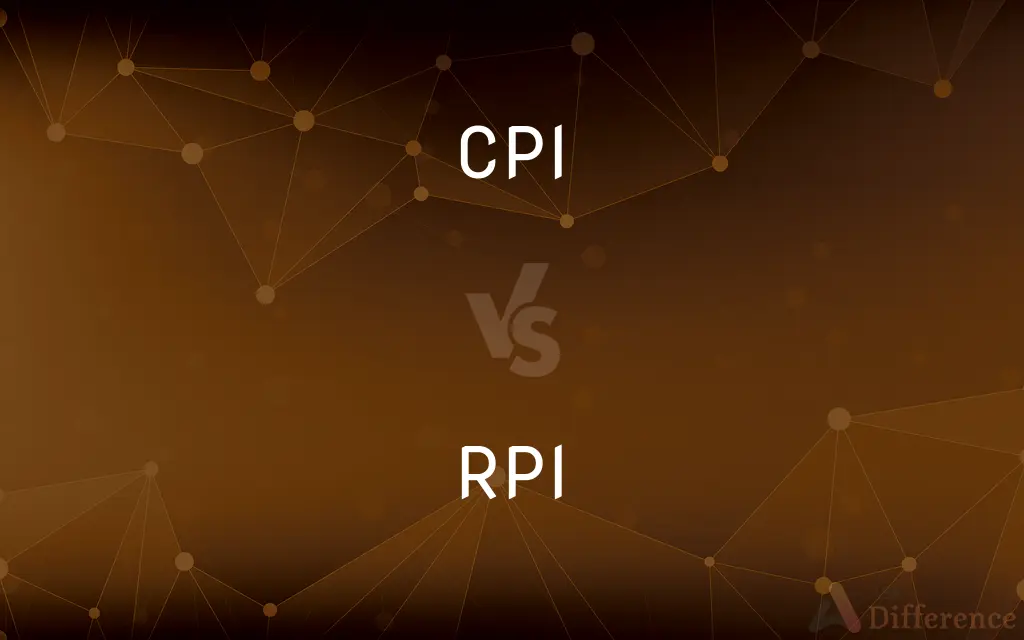CPI vs. RPI — What's the Difference?
By Tayyaba Rehman — Published on December 16, 2023
CPI (Consumer Price Index) measures average changes in prices paid by consumers for goods and services, while RPI (Retail Price Index) includes housing costs and is an older measure. Both track inflation.

Difference Between CPI and RPI
Table of Contents
ADVERTISEMENT
Key Differences
CPI, or the Consumer Price Index, is a widely used measure that tracks the average change over time in the prices of goods and services consumed by households. It's a key tool for policymakers and economists to gauge inflationary pressures. RPI, the Retail Price Index, also serves a similar purpose in tracking inflation but includes additional components like mortgage interest payments and housing costs.
While both CPI and RPI are employed to understand inflation, their methodologies differ. CPI does not consider housing costs like mortgage interest payments and council tax which are included in RPI. This can lead to differences in the inflation rate as reported by each index, with RPI typically being higher than CPI.
Another distinction between CPI and RPI is their usage. Many governments use CPI as the official measure of inflation, informing decisions on monetary policy. On the other hand, RPI, despite being older and having a broader scope, is not considered as statistically robust as CPI and is thus less favored for official inflation targeting.
The formulae employed to calculate CPI and RPI are also different. CPI uses the geometric mean, which tends to give a lower weight to items with rapidly changing prices. RPI, conversely, uses the arithmetic mean, typically resulting in higher inflation figures. Lastly, while CPI is more universally recognized and used globally, RPI is more specific to certain countries, such as the UK.
Comparison Chart
Definition
Measures average changes in prices paid by consumers.
Includes additional costs like housing.
ADVERTISEMENT
Formula
Uses geometric mean.
Uses arithmetic mean.
Housing Costs
Excludes most housing-related costs.
Includes costs like mortgage interest payments.
Usage
More widely used for official inflation measurements globally.
More specific to certain countries, e.g., the UK.
Typical Result
Generally reports a lower rate of inflation.
Typically shows a higher inflation rate.
Compare with Definitions
CPI
Used by economists to understand inflation trends.
The Federal Reserve often references the CPI in its reports.
RPI
Not the preferred measure for official inflation targeting due to methodological concerns.
Despite its broader scope, RPI is not the primary choice for policy decisions.
CPI
A tool informing monetary policy decisions.
The central bank adjusted rates based on the latest CPI data.
RPI
Older than CPI and specific to some regions like the UK.
While the UK has both RPI and CPI, RPI is the older measure.
CPI
Excludes certain housing-related costs.
Unlike the RPI, the CPI doesn't consider mortgage interests.
RPI
Incorporates mortgage interest payments in its calculations.
House owners often find the RPI more representative due to its housing cost considerations.
CPI
An index measuring average changes in prices for consumer goods and services.
Inflation is often gauged using the CPI.
RPI
Calculated using the arithmetic mean.
RPI's use of the arithmetic mean can lead to higher reported inflation.
CPI
The consumer price index, an index of the cost of all goods and services to a typical consumer. The increase of this value each year is one measure of monetary inflation.
RPI
An index that includes prices of consumer goods, services, and housing costs.
RPI often reports a higher inflation rate due to its inclusion of housing costs.
CPI
An index of the cost of all goods and services to a typical consumer
CPI
A self-report personality inventory originally derived from the MMPI; consists of several hundred yes-no questions and yields scores on a number of scales including dominance and self acceptance and self control and socialization and achievement etc.
CPI
Calculated using the geometric mean.
The CPI's use of the geometric mean can result in lower inflation figures.
Common Curiosities
What does CPI stand for?
CPI stands for Consumer Price Index.
Do both CPI and RPI measure inflation?
Yes, both CPI and RPI track inflation but use different methods and components.
Which one includes housing costs?
RPI includes housing costs like mortgage interest payments, while CPI typically does not.
And RPI?
RPI stands for Retail Price Index.
Which index typically reports higher inflation?
RPI usually reports higher inflation due to its inclusion of housing costs and its calculation method.
Where is RPI commonly used?
RPI is more specific to certain countries, particularly the UK.
How is CPI calculated?
CPI is calculated using the geometric mean.
Are these indices used in financial markets?
Yes, both CPI and RPI can impact financial markets as they influence monetary policy decisions.
Are there any controversies related to these indices?
Yes, debates often arise over which index is more representative and accurate for various purposes.
Do all countries have their own CPI and RPI data?
Most countries publish CPI data, but RPI is specific to certain nations like the UK.
Which index is older?
RPI is the older measure compared to CPI.
Why might someone prefer CPI over RPI?
CPI is often seen as more statistically robust and is more widely adopted for official measures.
Is CPI used globally?
Yes, CPI is a recognized measure used globally to assess inflation.
Can these indices impact my everyday life?
Yes, as they can influence economic policies which in turn can affect interest rates, wages, and prices.
Share Your Discovery

Previous Comparison
Self Actualization vs. Self Realization
Next Comparison
Supply vs. Quantity SuppliedAuthor Spotlight
Written by
Tayyaba RehmanTayyaba Rehman is a distinguished writer, currently serving as a primary contributor to askdifference.com. As a researcher in semantics and etymology, Tayyaba's passion for the complexity of languages and their distinctions has found a perfect home on the platform. Tayyaba delves into the intricacies of language, distinguishing between commonly confused words and phrases, thereby providing clarity for readers worldwide.
















































